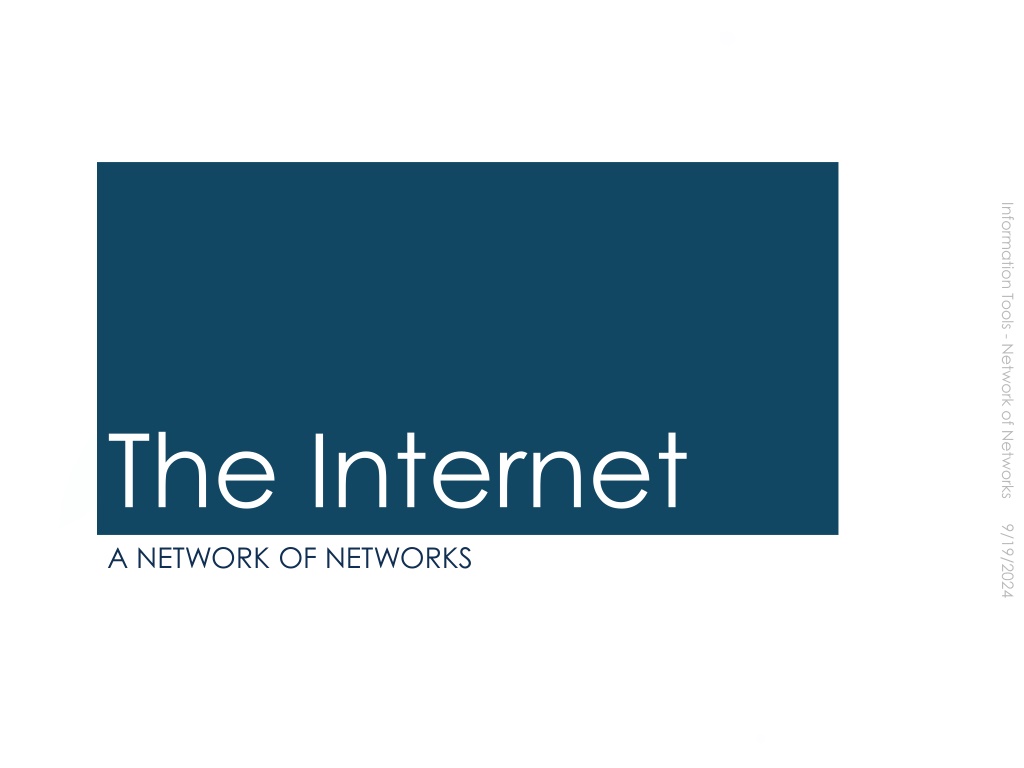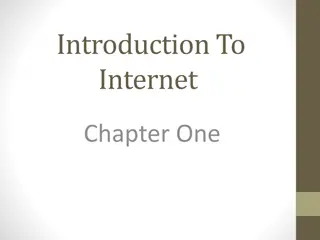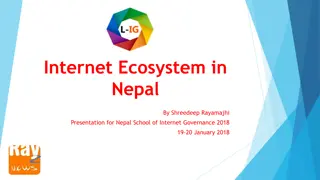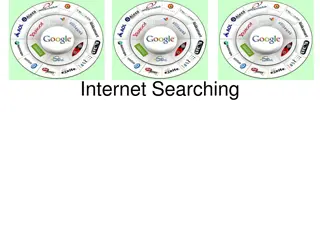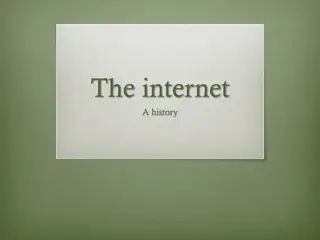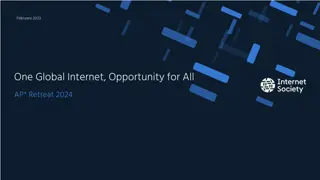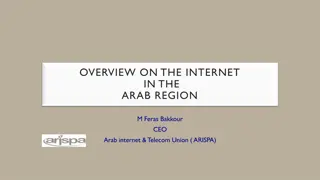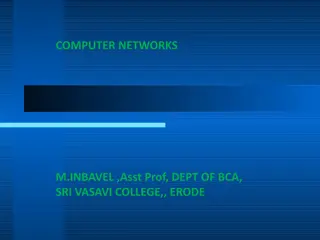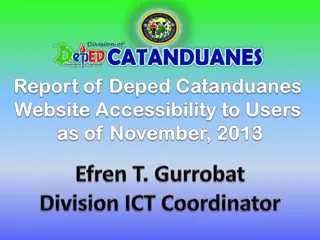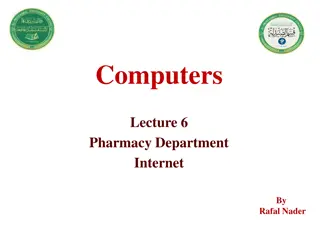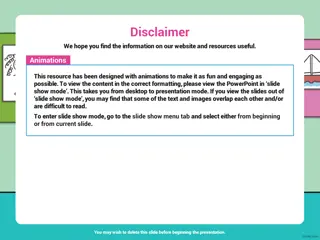The Evolution of the Internet: A Journey Through Time
Explore the history and growth of the Internet through key milestones such as the ARPANET, TCP/IP standard model, and the transition to NSF funding. Witness the expansion of connectivity, user growth, and the impact on global communication. From the early days of resilient network design to the widespread accessibility driven by government, industry, and market support, this journey showcases the transformation of the Internet into a vital global network.
Download Presentation

Please find below an Image/Link to download the presentation.
The content on the website is provided AS IS for your information and personal use only. It may not be sold, licensed, or shared on other websites without obtaining consent from the author. Download presentation by click this link. If you encounter any issues during the download, it is possible that the publisher has removed the file from their server.
E N D
Presentation Transcript
The Internet A NETWORK OF NETWORKS
Based on standards A NETWORK OF NETWORKS
The TCP/IP Standard Model protocols & standards are key
History ... A RAND study led to the myth that the ARPANET was somehow related to building a network resistant to nuclear war This was never true of the ARPANET, only the unrelated RAND study on secure voice considered nuclear war. However, the later work on Internetting did emphasize robustness and survivability, including the capability to withstand losses of large portions of the underlying networks.
Remember Fort Lee AFS, Virginia? life in a SAGE blockhouse life in a SAGE blockhouse
Advanced Research Projects Agency Net ARPA managed (and funded) for 15+ years a record of the first message ever sent over the ARPANET; it took place at 10:30PM on October 29, 1969.
NSF took over - 1986 Give the technology to the masses, not just to academia NSF funded the backbone for 7-8 years Connectivity proliferated
1994 - NSF ceased direct support Click for larger image Now funded by the market , government, industry Growth 2000-2007 Growth 2000-2007
2009 user growth expanding More users in China than in USA
2009 user growth expanding More users in China than in USA
2009+ connectivity connects Almost no limit to usages http://farm6.static.flickr.com/5009/5349092555_79914e4085_o.png
2009+ connectivity connects Almost no limit to usages
2009+ connectivity connects Almost no limit to usages
Whats going on now? Lots of stuff http://img.gawkerassets.com/img/18vdqx6048bj3png/ku-bigpic.png
But why did it grow so? ACCESS TO INFORMATION THROUGH STANDARDS
Some of these are key Transport and application layer protocols (i.e. TCP, HTTP, FTP) ensure that the sender and receiver are speaking the same language, and that the communication can be interpreted protocols & standards are key
Servers, again Servers can be physical computers Servers can also be software applications One server (physical computer) can run many servers (software applications) at a time For example, Isis has several: listproc web ftp mail address book Web server market share
Servers, again over time Servers can be physical computers http://gigaom2.files.wordpress.com/2013/08/web-server-market-share-august-2013.jpg?w=648
Servers, again Servers can be physical computers One of Google s server farms One of Google s server farms
Servers, again Servers can be physical computers One of Google s server farms One of Google s server farms How does the host application know when the data being received is for it?
Ports Each software server listens on a different port Some common ports are: web (80) FTP (20,21) telnet (23) smtp (25) The combination of IP address and port number dictates where the data goes Who assigns ports?
Clients, again For any given application, there can be many clients People are more familiar with clients, since they interface with them directly Examples of clients are: browsers FTP clients Email clients Web browser market share
Clients, again For any given application, there can be many clients People are more familiar with clients, since they interface with them directly Examples of clients are: browsers FTP clients Email clients http://cdn.static-economist.com/sites/default/files/imagecache/595-width-retina/20130810_GDM861_1190.png
Clients, again For any given application, there can be many clients People are more familiar with clients, since they interface with them directly Examples of clients are: browsers FTP clients Email clients
Clients, again For any given application, there can be many clients People are more familiar with clients, since they interface with them directly Examples of clients are: browsers FTP clients Email clients
Lets use the web as an example The client (your web browser) sends a request for a URL to a server The server finds the requested page and sends it back to the client The protocol used is called HTTP (HyperText Transfer Protocol) Many different types of clients, and many different types of servers, but all work the same
How do you know what to ask for? j0401797 there is only one Web naming/addressing technology: URIs. Uniform Resource Identifiers (URIs, aka URLs) are short strings that identify resources in the web: documents, images, downloadable files, services, electronic mailboxes, and other resources. According to the W3C
Anatomy of a URL [Uniform or Universal Resource Locator] http://www.unc.edu/~onyen/pwd Protocol Host port name Domain name Item requested ~onyen/pwd unc.edu/ http:// www. Fully qualified hostname
URLs go to file locations: IP addresses go to servers http://www.unc.edu/~onyen/pwd Host port name Item requested Host IP address ~onyen/pwd http://193.145.50.56 The alternate site for Information Visualization is in Spanish. The server will return this default root page when a request is made by IP address. A URL allows the client to request a specific page on the server, such as the English version.
Anatomy of a URL [Uniform or Universal Resource Locator] http://opal.ils.unc.edu/~onyen/pwd Protocol Host port name Domain name Item requested http:// opal.ils. unc.edu/ ~onyen/pwd Fully qualified hostname But how does one find that name on the Internet?
Domain Name System an Internet service that translates domain names into IP addresses. Because domain names are alphabetic, they're easier to remember. The Internet however, is really based on IP addresses. Every time you use a domain name, therefore, a DNS service must translate the name into the corresponding IP address. The DNS system is, in fact, its own network. If one DNS server doesn't know how to translate a particular domain name, it asks another one, and so on, until the correct IP address is returned.
Naming vs. Addressing Alice.com 129.86.8.90 Bob.edu 129.86.8.91 Names are tied to IP addresses
How does Alice find Bob? Bob.edu is a name, not an address the address could be: 152.2.81.1 Alice.com An Internet Address is 129.86.8.90 4 byte (32 bit) number 4 billion hosts possible (in theory, but...) Bob.edu 129.86.8.91 Doled out by Internet Assigned Numbers Authority Names are tied to IP addresses ensures adjacency , no clashes
Why Names? One could use 207.46.130.149 instead of www.microsoft.com IP addresses for configurability and administrative control, but names for human memory To connect the two, we use
The Domain Name System (DNS) Interspersed all over the internet are specialized servers that translate names into IP addresses A DNS server stores the name/address pair Bob.edu is a domain name Domain Name System is hierarchical
DNS Example opal.ils.unc.edu Host name Top Level Domain Specificity Most Least
A Sample DNS Hierarchy opal.ils.unc.edu edu Admin zones unc virginia cs ils its ... ... ruby ... denali opal
Lets see how it works Alice.com 129.86.8.90 Bob.edu 129.86.8.91 Names are tied to IP addresses
Suppose Alice talks to Bob ... Alice creates a message on his client and then the TCP/IP system looks for a Hi, Bob, what s up? Domain Name Server Alice.com Bob.edu
Name Resolution in DNS Alice s computer DNS Server Bob.edu?? Name sally.edu harry.com ruby.ils.unc.edu 152.2.81.1 microsoft.com Address 129.86.8.90 129.86.8.91 1. Resolve Name Alice.com Bob.edu 207.68.156.68 2. Send Message Hi, Bob, what s up? TCP/IP Hi, B ob , W hat s up? Another explanation Another explanation To 129.86.8.90
Name Resolution in DNS two other schematics Another explanation Another explanation
How do we find these servers and these locations? We can use our tools, such as traceroute Either using Unix tools on our server
How do we find these servers and who is behind these locations? We can use our tools, such as whois traceroute or web based tools
but thats for you to try out ON YOUR OWN
